NASA Spotlight: Astronaut Candidate Frank Rubio

NASA Spotlight: Astronaut Candidate Frank Rubio
“Where else in the world would you hear a story like mine? I’m a kid from a single mom, a teenage mom from El Salvador who worked in all sorts of low-income jobs... My story is a great story about America. What are the chances that a kid like me would end up being where I am today?” - Frank Rubio
Dr. Frank Rubio is a Los Angeles-born Salvadorian-American who was selected as NASA astronaut candidate in 2017. The Florida native graduated from the U.S. Military Academy and earned a Doctorate of Medicine from the Uniformed Services University of the Health Sciences. Prior to attending medical school, he served as a UH-60 Blackhawk helicopter pilot and flew more than 1,100 hours, including more than 600 hours of combat and imminent danger time during deployments to Bosnia, Afghanistan and Iraq. Dr. Rubio is a board certified family physician and flight surgeon. At the time of his selection, he was serving in the 10th Special Forces Group (Airborne).
Frank took time from training to become a certified NASA Astronaut to answer questions about his life and career:
You’ve served in the Special Forces, are certified as a family physician and now are a selected Astronaut candidate – What inspired you to apply to be an astronaut and how do you think your past jobs will play a role in your new career?
It was a friend in the astronaut corps that recommended I put in an application. After he recommended it, I thought it was an amazing opportunity to be a part of something bigger than myself and to allow me to continue to serve. It gave me an opportunity to explore and make a difference. And it sounded like a lot of fun! My past careers have allowed me to be comfortable with uncertainty and the unknown and to function well despite often not having all the facts.
Do you have any secret skills, talents, or hobbies?
I was on the skydive team in college.

How would you describe your job to a five year old?
I have one of the best jobs in the world because I get to train and work towards a mission that helps humankind. My job is unique in that you and your team are working to make a difference from a much bigger perspective. And hopefully I get to ride on a rocket and go to space!

What is the best advice you’ve ever received?
Early in my career and throughout my career I was assigned to jobs that may not have been my first choice, but they turned out to be amazing opportunities. I was taught to have a good attitude and give it your best no matter where you are. Those opportunities ended up being some of the best and helped me get where I am today.
Any facts about/aspects of astronaut training that you think people would be surprised to find out?
A lot of people don’t realize how much studying is involved. It’s comparable to the studying I did in flight school or medical school.
What are five things that you will definitely take with you on your first space flight?
Pictures of my family and friends, a Bible and lots of books to read (probably on a tablet), patches from my Army units- they helped form me to be the person I am today, music, and if I could take my dog (and family), I definitely would! Also, Something for each of my kids to give to them.
You just finished up geology training. What fact or skill did you learn during geology training that you think rocks the most?
The overall idea that the rocks and the different units we studied have so much to tell. You learn to appreciate how much the layout of the land and the rocks and the way they interact together can tell you about the history of that place. It’s amazing.

Since you’re getting close to completing astronaut training, what about your first space flight are you most looking forward to?
Everything will be fantastic from the ride up there, to floating in space, to the amazing science we get to perform, to being part of the team. I don’t think I’ll ever get tired of looking back at Earth and having the chance to get the perspective to recognize the grandeur and uniqueness of Earth.
What would be the first thing you would say if you happened to make contact with an alien lifeform able to communicate with you?
Hello! How are you? I would want to know about them and to share humankind with them.
Thank you for your time Frank, and good luck as you continue to complete astronaut training!
Make sure to follow us on Tumblr for your regular dose of space: http://nasa.tumblr.com.
More Posts from Nasa and Others
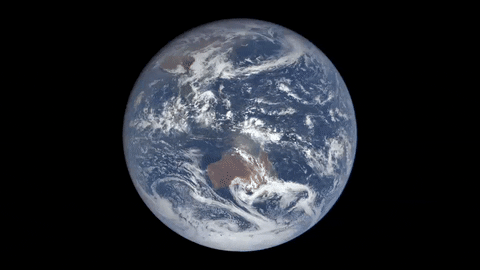
Happy 50th Anniversary of Earth Day! 💙🌍
We’re so glad you could join us for this special Earth edition of Tumblr Answer Time. Today is a perfect day to learn about our home planet directly from the people who work to keep it safe.
Kick off starts NOW!
Our Acting Director of Earth Sciences, Sandra Cauffman, and Associate Administrator for the Science Mission Directorate, Dr. Thomas Zurbuchen have answers to your questions from their homes! Enjoy.
Make sure to follow us on Tumblr for your regular dose of space: http://nasa.tumblr.com.
Experience How Microgravity Affects the Human Body
Now is your chance to experience what it’s like to live and work on the International Space Station! The new NASA Science: Humans in Space app will let you explore the station while virtually experiencing what it does to your body.

Life in space is no float in the park. Astronauts contend with everything from motion sickness to face swelling to loss of bone density. That’s why many research investigations on the space station study how humans can better adapt to microgravity both in Earth's orbit as well as on longer missions to the Moon and Mars.

Deal with these challenges and perform crucial daily workouts as you explore the orbiting laboratory and ensure the H-II Transfer Vehicle successfully berths to the station.

You can even collect mission patches along the way for completing tasks, counteracting the effects of microgravity and making discoveries.

Download the application for Android here and iPhone here. Find more NASA apps here.
Want to learn about more investigations heading to the space station (or even ones currently under way)? Make sure to follow @ISS_Research on Twitter and Space Station Research and Technology News on Facebook.
Make sure to follow us on Tumblr for your regular dose of space: http://nasa.tumblr.com.
NASA’s 60th Anniversary: What’s Out There
In the past 60 years, we’ve advanced our understanding of our solar system and beyond. We continually ask “What’s out there?” as we advance humankind and send spacecraft to explore. Since opening for business on Oct. 1, 1958, our history tells a story of exploration, innovation and discoveries. The next 60 years, that story continues. Learn more: https://www.nasa.gov/60
Make sure to follow us on Tumblr for your regular dose of space: http://nasa.tumblr.com.
Why Isn’t Every Year the Warmest Year on Record?
This just in: 2022 effectively tied for the fifth warmest year since 1880, when our record starts. Here at NASA, we work with our partners at NOAA to track temperatures across Earth’s entire surface, to keep a global record of how our planet is changing.
Overall, Earth is getting hotter.

The warming comes directly from human activities – specifically, the release of greenhouse gases like carbon dioxide from burning fossil fuels. We started burning fossil fuels in earnest during the Industrial Revolution. Activities like driving cars and operating factories continue to release greenhouse gases into our atmosphere, where they trap heat in the atmosphere.

So…if we’re causing Earth to warm, why isn’t every year the hottest year on record?
As 2022 shows, the current global warming isn’t uniform. Every single year isn’t necessarily warmer than every previous year, but it is generally warmer than most of the preceding years. There’s a warming trend.
Earth is a really complex system, with various climate patterns, solar activity, and events like volcanic eruptions that can tip things slightly warmer or cooler.
Climate Patterns
While 2021 and 2022 continued a global trend of warming, they were both a little cooler than 2020, largely because of a natural phenomenon known as La Niña.
La Niña is one third of a climate phenomenon called El Niño Southern Oscillation, also known as ENSO, which can have significant effects around the globe. During La Niña years, ocean temperatures in the central and eastern Pacific Ocean cool off slightly. La Niña’s twin, El Niño brings warmer temperatures to the central and eastern Pacific. Neutral years bring ocean temperatures in the region closer to the average.

El Niño and La Niña affect more than ocean temperatures – they can bring changes to rainfall patterns, hurricane frequency, and global average temperature.
We’ve been in a La Niña mode the last three, which has slightly cooled global temperatures. That’s one big reason 2021 and 2022 were cooler than 2020 – which was an El Niño year.
Overall warming is still happening. Current El Niño years are warmer than previous El Niño years, and the same goes for La Niña years. In fact, enough overall warming has occurred that most current La Niña years are warmer than most previous El Niño years. This year was the warmest La Niña year on record.

Solar Activity
Our Sun cycles through periods of more and less activity, on a schedule of about every 11 years. Here on Earth, we might receive slightly less energy — heat — from the Sun during quieter periods and slightly more during active periods.

At NASA, we work with NOAA to track the solar cycle. We kicked off a new one – Solar Cycle 25 – after solar minimum in December 2019. Since then, solar activity has been slightly ramping up.
Because we closely track solar activity, we know that over the past several decades, solar activity hasn't been on the rise, while greenhouse gases have. More importantly, the "fingerprints" we see on the climate, including temperature changes in the upper atmosphere, don't fit the what we'd expect from solar-caused warming. Rather they look like what we expect from increased greenhouse warming, verifying a prediction made decades ago by NASA.
Volcanic Eruptions
Throughout history, volcanoes have driven major shifts in Earth’s climate. Large eruptions can release water vapor — a greenhouse gas like carbon dioxide — which traps additional warmth within our atmosphere.
On the flip side, eruptions that loft lots of ash and soot into the atmosphere can temporarily cool the climate slightly, by reflecting some sunlight back into space.
Like solar activity, we can monitor volcanic eruptions and tease out their effect on variations in our global temperature.

At the End of the Day, It’s Us
Our satellites, airborne missions, and measurements from the ground give us a comprehensive picture of what’s happening on Earth every day. We also have computer models that can skillfully recreate Earth’s climate.
By combining the two, we can see what would happen to global temperature if all the changes were caused by natural forces, like volcanic eruptions or ENSO. By looking at the fingerprints each of these climate drivers leave in our models, it’s perfectly clear: The current global warming we’re experiencing is caused by humans.
For more information about climate change, visit climate.nasa.gov.
Make sure to follow us on Tumblr for your regular dose of space!
Space Gardening 101
You can’t escape eating (or gardening!) your vegetables, even if you’re in space. On Aug. 10, astronauts on the International Space Station sampled their first space grown salad. This freshly harvest red romaine lettuce was grown in the “Veggie” plant growth chamber that is designed to make gardens flourish in weightlessness.
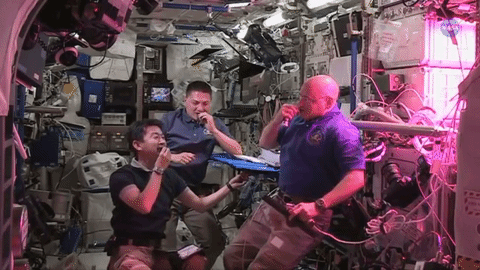
In a weightless environment, there is no up and down, so roots grow in all directions. Water and soil, the materials used to anchor these plants and allow for root growth tend to float away.
How Do We Grow Plants in Space?
1. Plant Pillows
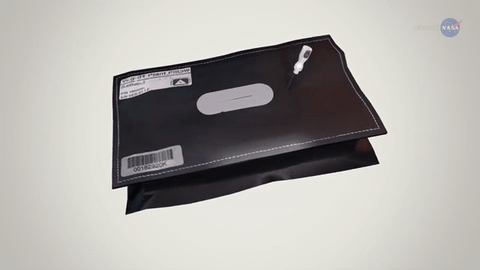
The Veggie chamber helps solve the problems of a weightless environment by using ‘plant pillows’, sounds comfy right? These pillows are bags filled with material for growing plants in space.
2. Wicks

Wicks are implanted into the bags and are used to draw water from inside the pillow to the plant.
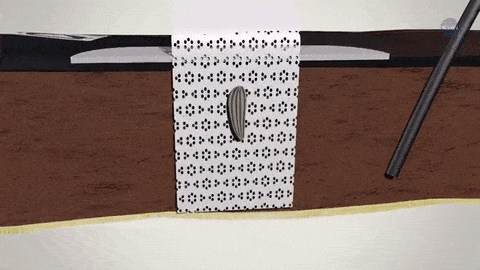
These wicks also provide a place to glue the seeds. It’s important to orient the seeds so roots will grow ‘down’, and shoots that emerge will push out of the bag.
3. LED Lights
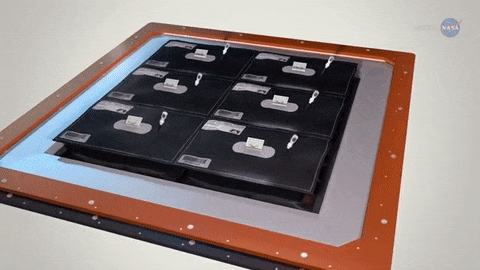
LED lights are used for photosynthesis and give the shoots a sense of direction so they keep growing upward. The walls of the Veggie chamber can expand to make room for the plant as it grows.
The purple/pinkish hue surrounding the plants in Veggie is the result of a combination of the red and blue lights, which is what the plants need to grow. Green LEDS were added so the plants look like edible food rather than weird purple plants.
Why are we growing plants in space?
When astronauts travel on deep space missions, like Mars, they will need to be self-sufficient for long periods of time. Having the ability to grow their own food is a big step in that direction. There is also a desire to grow flowering vegetables in space, which is why we are currently tending to zinnia flowers on orbit. Growing these flowering plants will help us understand longer duration growing plants that have to flower in space, such as tomatoes.
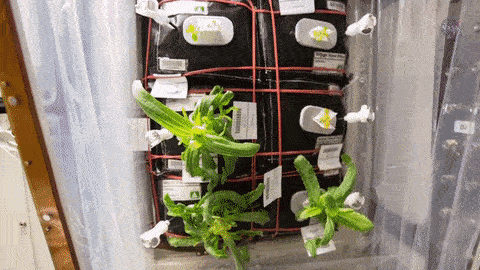
What’s Next? The next SpaceX delivery will include seeds for a small cabbage and additional red romaine lettuce. Upcoming experiments will use various ratios of red and blue lights and different fertilizers in attempts to improve crop yield, nutrition and flavor. The findings from these experiments can be utilized both on Earth and in space.
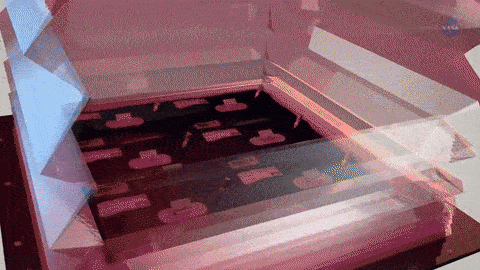
In addition to the nutrition benefits of growing vegetables in space, the psychological benefits are also significant. Having living plants can help with stress and increase the crews’ enjoyment. It provides the sights, smells and tastes of Earth.
To learn more about gardening in space, watch ScienceCast HERE.
Make sure to follow us on Tumblr for your regular dose of space: http://nasa.tumblr.com
So you want to work at NASA?
An out of this world career or internship might not be as far out of reach as you think. Check out all the ways you can get involved!
If you’re a student…

Our internships are the perfect place to start! We offer paid internships for spring, summer, and fall semesters to U.S. citizens currently attending an accredited university full time. Learn more at: https://intern.nasa.gov
Seriously considering a job in the Federal civil service? Check out the Pathways Internship Program which allows you to do multiple work tours while you finish school: http://nasajobs.nasa.gov/studentopps/employment/iep.htm
If you’re a recent graduate…
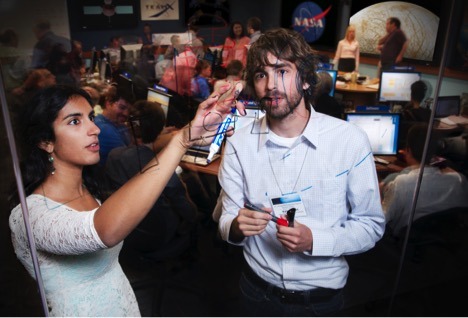
If you’re a U.S. citizen who has graduated from an accredited college or university within the past 2 years (or 6 if you have served in the military), then the our Recent Graduates program is just for you. Accepted applicants are placed in a 1 year career development program with the possibility of an additional year, or even granted term or permanent jobs within the agency. Learn more at: http://nasajobs.nasa.gov/studentopps/employment/rgp.htm.
If you’re a professional…

You can search for our job openings any time at USAJobs.com. Create an account, then use the USAJobs resume builder. Want to make sure your resume maximizes your opportunity for a job at NASA? Check out our Applicant Guide: https://applyonline.nasa.gov/applicant_guide.html.
You can then search for our job openings here: https://nasai.usajobs.gov/.
If you want to be an astronaut…

Astronaut candidate applications are accepted every few years- including right now! Get yours in before the current application closes on February 18, 2016.
Do you have a bachelor’s degree in a STEM field and 3 years of related professional experience? You might be eligible. Find out more and apply online at: https://nasai.usajobs.gov/GetJob/ViewDetails/423817000.
Make sure to follow us on Tumblr for your regular dose of space: http://nasa.tumblr.com
Astronaut in the house!
Air Force Colonel and NASA Astronaut Nick Hague is back from his seven month stay aboard the space station and ready to answer your questions in today's Tumblr Answer Time!
Let's get started.
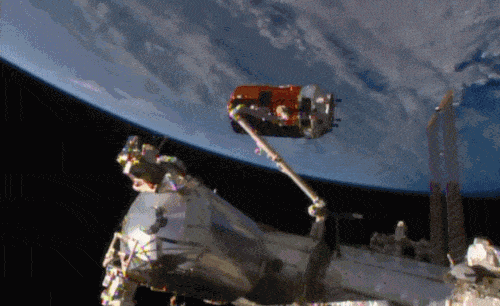
Aboard the International Space Station this morning, Astronaut Kimiya Yui of the Japan Aerospace Exploration Agency (JAXA) successfully captured JAXA's Kounotori 5 H-II Transfer Vehicle (HTV-5) at 6:28 a.m. EDT.
Yui commanded the station's robotic arm, Canadarm2, to reach out and grapple the HTV-5, while NASA astronauts Kjell Lindgren provided assistance and Scott Kelly monitored HTV-5 systems. The HTV-5 launched aboard an H-IIB rocket at 7:50 a.m. Wednesday, Aug. 19, from the Tanegashima Space Center in southern Japan. Since then, the spacecraft has performed a series of engine burns to fine-tune its course for arrival at the station.
The HTV-5 is delivering more than 8,000 pounds of equipment, supplies and experiments in a pressurized cargo compartment. The unpressurized compartment will deliver the 1,400-pound CALorimetric Electron Telescope (CALET) investigation, an astrophysics mission that will search for signatures of dark matter and provide the highest energy direct measurements of the cosmic ray electron spectrum.
Below is a breathtaking image shared by Astronaut Scott Kelly of the HTV-5 and Canadarm2, which reached out and grappled the cargo spacecraft.

For more information, visit: https://www.missionjuno.swri.edu/junocam/processing?id=182

Purple haze, all around. See Jupiter in a whole new light in this citizen scientist-created JunoCam image.
The Rover Doctor is in: The Anatomy of a NASA Human Exploration Rover Challenge Rover
Exploration and inspiration collide head-on in our Human Exploration Rover Challenge held near Marshall Space Flight Center in Huntsville, Alabama, each April. The annual competition challenges student teams from around the world to design, build and drive a human-powered rover over a punishing half-mile course with tasks and obstacles similar to what our astronauts will likely have on missions to the Moon, Mars and beyond.

The anatomy of the rover is crucial to success. Take a look at a few of the vital systems your rover will need to survive the challenge!
The Chassis

A rover’s chassis is its skeleton and serves as the framework that all of the other rover systems attach to. The design of that skeleton incorporates many factors: How will your steering and braking work? Will your drivers sit beside each other, front-to-back or will they be offset? How high should they sit? How many wheels will your rover have? All of those decisions dictate the design of your rover’s chassis.
Wheels

Speaking of wheels, what will yours look like? The Rover Challenge course features slick surfaces, soft dunes, rocky craters and steep hills – meaning your custom-designed wheels must be capable of handling diverse landscapes, just as they would on the Moon and Mars. Carefully cut wood and cardboard, hammer-formed metal and even 3-D printed polymers have all traversed the course in past competitions.
Drivetrain

You’ve got your chassis design. Your wheels are good to go. Now you have to have a system to transfer the energy from your drivers to the wheels – the drivetrain. A good drivetrain will help ensure your rover crosses the finish line under the 8-minute time limit. Teams are encouraged to innovate and think outside the traditional bike chain-based systems that are often used and often fail. Exploration of the Moon and Mars will require new, robust designs to explore their surfaces. New ratchet systems and geared drivetrains explored the Rover Challenge course in 2019.
Colors and Gear

Every good rover needs a cool look. Whether you paint it your school colors, fly your country’s flag or decorate it to support those fighting cancer (Lima High School, above, was inspired by those fighting cancer), your rover and your uniform help tell your story to all those watching and cheering you on. Have fun with it!

Are you ready to conquer the Rover Challenge course? Join us in Huntsville this spring! Rover Challenge registration is open until January 16, 2020 for teams based in the United States.
If building rovers isn’t your space jam, we have other Artemis Challenges that allow you to be a part of the NASA team – check them out here.

Want to learn about our Artemis program that will land the first woman and next man on the Moon by 2024? Go here to read about how NASA, academia and industry and international partners will use innovative technologies to explore more of the lunar surface than ever before. Through collaborations with our commercial, international and academic partners, we will establish sustainable lunar exploration by 2028, using what we learn to take astronauts to Mars.
The students competing in our Human Exploration Rover Challenge are paramount to that exploration and will play a vital role in helping NASA and all of humanity explore space like we’ve never done before!
Make sure to follow us on Tumblr for your regular dose of space: http://nasa.tumblr.com
-
 armchair-misanthrope liked this · 1 year ago
armchair-misanthrope liked this · 1 year ago -
 rruechetaughtme reblogged this · 2 years ago
rruechetaughtme reblogged this · 2 years ago -
 georgemccaw reblogged this · 3 years ago
georgemccaw reblogged this · 3 years ago -
 lutefisk-kingdom liked this · 3 years ago
lutefisk-kingdom liked this · 3 years ago
Explore the universe and discover our home planet with the official NASA Tumblr account
1K posts